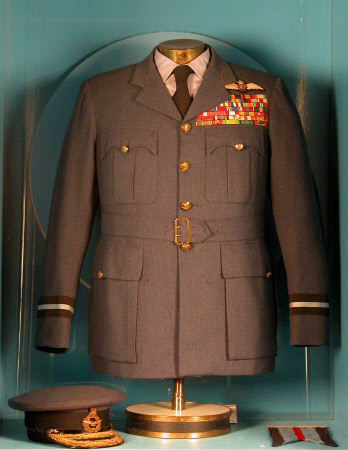Air Commodore of the Royal Auxiliary Air Force
Category
Costume
Date
Unknown
Materials
Wool, silk twill and ribbon
Order this imageCollection
Chartwell, Kent
NT 1102768.1
Summary
R.A.F. Service dress as an Air Commodore of the Royal Auxiliary Air Force, tunic with medal ribbons, and badges of rank. Displayed with (1102768.2) service braided cap. Also displayed with blue/grey shirt and black tie. 1969 Schedule P.124
Provenance
This is Sir Winston Churchill’s Air Commodore Uniform for the Auxiliary Air Force (later referred to as the Royal Auxiliary Air Force), and it can be found in the Uniform Room at Chartwell. The Auxiliary Air Force was founded in 1924 by the then Chief of the Air Staff, Lord Trenchard. The aim of this new organisation was to encourage young men to become interested in flying and train as pilots in their free time. By 1939 there were twenty regular squadrons, fourteen of which saw action in the Battle of Britain. On 1 February 1939 Churchill’s friend Sir Phillip Sassoon, Under Secretary of State for Air, asked him to become the Honorary Air Commodore of No. 615 (County of Surrey) Squadron. Churchill replied to him two days later on 3 February that, “… I shall be very glad to accept provided you do not expect me to fly too high.” Churchill had been flying many times before this appointment most notably with the Royal Naval Air Service before the First World War. Squadron 615 was based at Kenley in Surrey and was formed on 1 June 1937. This particular squadron was involved in the Second World War, and not only played a role in the early stages of the Battle of Britain, but also went to France in November 1939 as part of the Air Component of the British Expeditionary Force as well as played a role in India and the Far East. This squadron flew Gladiators, Hurricanes and in 1943 received Spitfires during the Second World War. Churchill visited the squadron frequently both during and after the war and the pilots were invited to visit Chartwell in August 1951. He also wore this uniform on many occasions including the 1943 Teheran Conference and on a visit to Normandy in August 1944. This uniform was made by Austin Reed Ltd, a London based firm, who during the Second World War specialised in producing uniforms for the armed forces, as well as foreign uniforms to resistance groups. Also in the case with the uniform are his pilot hat and the Air Commodore’s pennant of the use on his official car.
